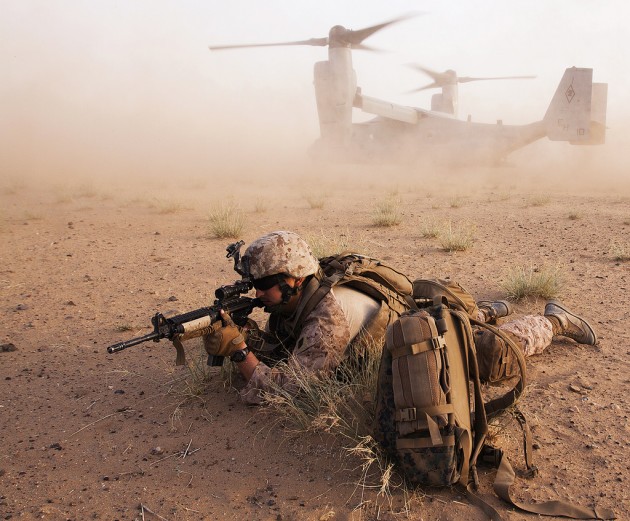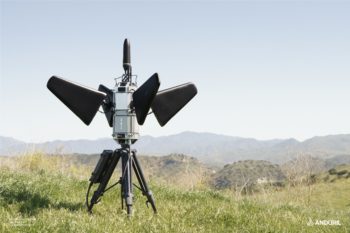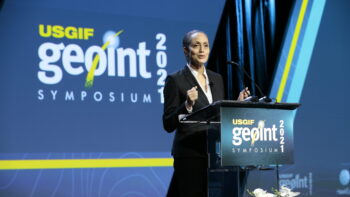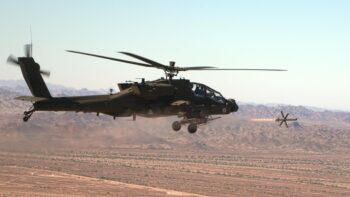The story of what two Marine aviators did to be the first V-22 Osprey pilots awarded Distinguished Flying Crosses is simple, elegant, and and tactically telling. The double-DFC incident underscores how the Marines are using the unique tilt-rotor aircraft — which can take off and land like a helicopter, then fly long distances at high speeds like an airplane — and its ability to perform in extreme battlefield conditions.
I interviewed the two pilots, Major Michael Hutchings and Captain David Haake, at New River Air Station.
Here’s what happened in Afghanistan in June 2012. Two Ospreys, operating with conventional helicopters — Hueys and Cobras — were supporting the insertion of a Marine reconnaissance battalion. The Ospreys, piloted by Maj. Hutchings and Capt. Haake, were flying in a two-ship formation and planning to put down Marines in two waves.
The first wave went well, and the Ospreys returned to insert the second group of Marines, to provide the enough armed manpower to perform the mission in Taliban infested territory.
As Hutching’s V-22 came down it took heavy fire, which so damaged the plane that the systems on board told the pilot to not fly the aircraft. Of course, not flying was to face certain death, so the task for the pilot and the crew was to find a way out. The plane was badly damaged, but because of the various redundant systems on board and the skill of the pilot and the crew, they were able to depart and to make it back to Camp Bastion in airplane mode. With a traditional rotorcraft, of course, you do not have the relative luxury of switching between two modes of travel.
As Haake followed Hutching in, the Hueys and Cobras informed him that Taliban were occupying the area around the intended landing zone. Haake took his plane up and took stock of his options. While he did, he learned that Hutchings had landed and was under attack, which meant that Haake had little choice but to insert Marines to reinforce the reconnaissance battalion. He did, also under heavy fire. His plane was badly damaged as well and also had on board a wounded Afghan soldier working with the Marines.
In addition to battle damage to the aircraft, the plane was leaking fuel very badly. This meant that the pilot and crew knew they could not make it back to Camp Bastion, but would have to land at a Forward Operating Base, which also had medical support, about 20 miles away. Again, flying on helicopter mode, the plane and crew made it to the base.
But for Maj. Hutchings, the day was not yet over. This was a night insertion so the Marines needed to be extricated the next day. Hutchings flew an Osprey the next morning as part of the effort to pick up the Marines and get them out. Hutchings landed the plane and took onboard the Marines, who were firing at the enemy as they boarded the plane. The Osprey took off to altitude with speed. “I asked the crew chief after about 10 minutes how the Marines in the back were doing. He said they were asleep,” Hutchings added.
Although their tale is the most dramatic testimony to the maturing of the Osprey, it was not the only one I heard. Frank “Blaine” Rhobotham, the Remain Behind Element Officer in Charge of VMM-365, provided another example of the impact of the Osprey and its maturity. He was the head maintainer involved in preparing the Special Purpose MAGTF, which now operates out of Southern Europe and is available to support missions in Africa and the Mediterranean.
Rhobotham discussed the very short period from the generation of the concept of the Special Purpose MAGTF to its execution. It took about eight months from inception to deployment. He emphasized the flexibility of the force and its light footprint. “With a six-ship Osprey force supported by three C-130s we can move it as needed. The three C-130s are carrying all the support equipment to operate the force as well.”
The flexibility which the Osprey now offers Combatant Commanders and US defense officials is a major strategic and tactical tool for the kind of global reality the US now faces, requiring rapid support and insertion of force.
Col. Michael Orr, Commanding Officer of VMX-22, the operational testing squadron for the Marines, provided a third example. This squadron is operating Ospreys, heavily involved in the roll out of the F-35B, and engaged in the Marines re-set on unmanned air systems.
Most recently, VMX-22 has been testing Ospreys aboard large deck carriers to contribute to large deck carrier operations. The near term focus is upon the replacement of C-2 Greyhounds to provide for aspects of carrier resupply. Obviously, the Osprey can provide much more capability than this.
“The big change which the Osprey brings is the ability to link together a diversity of assets at sea. Imagine an asset which can link the large deck carrier, amphibious ships, and the logistics fleet. The Osprey is such an asset and a key enabler to turn ships into a sea base,” Orr told me.
A fourth example comes from what I saw on the flight line. When I first saw Ospreys at New River several years ago, there were only five. Now a newly appointed Air Combat Element or ACE commander for the 22nd Marine Expeditionary Force, Lt. Col. Schoolfield, showed me the air group being assembled on the tarmac. It was an impressive array of aircraft, including the newly configured AH-1Z Cobras and UH-1Y “Yankees.”
The Ospreys were lined up almost as if they knew that they were the enabler now of the afloat Marines, and not an experiment. But to get to this point has required significant cultural change within the Corps itself. To deal with this requires leadership, and not just inside the Beltway. Commanders in the field and with the forces are crucial to such change.
One such leader is the retiring (in only one sense of the word) Col. Seymour, who is the CO of Marine Aircraft Group 26. During our interview, Seymour described the cultural changes necessary to deal with process of change. Leadership had to move forward in spite of resistance. As he reminded his Marines: “You are not stakeholders; you are Marines. Get on with it.”
Robbin Laird, a member of the Breaking Defense Board of Contributors, has published a new book, which looks at the impact of the evolution of Marine aviation on their approach to operations. Three Dimensional Warriors.
Anduril debuts Pulsar AI-powered electronic warfare system
Company executives claimed the Pulsar system can use AI tools to quickly identify new threats and devise defenses against them, compressing the timeline for responding to rapidly-evolving electronic warfare.



























